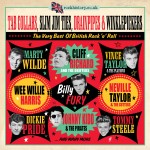 The Very Best Of British Rock ‘n’ Roll
The Very Best Of British Rock ‘n’ Roll
Rock & Roll got off to a fairly slow, low-key start in the UK, and it peaked late; indeed, it would take a couple of years before we got the collective bit between our teeth, the first genuine classic British R&R record (Cliff’s ‘Move It’, of course) not being recorded until the Summer of 1958. This compilation attempts the (near-impossible) task of presenting the Very Best of early UK R&R, and includes the handful of benchmark sides which stack up comfortably against their American counterparts.
In the United States, R&R had evolved organically, equal parts Blues, R&B, Hillbilly and Western Swing, flourishing prolifically throughout the South in the early 50s before exploding nationally, in 1954. But its arrival in the UK underwent an entirely different process – indeed, it actually came here in instalments, the first of which we’d been blissfully unaware… At that stage (circa 1953/54) it wasn’t yet called Rock & Roll, but around this time a number of the UK’s popular Variety singers (Alma Cogan, Frankie Vaughan, etc) began to cover various American ‘Big Beat’ hits which would subsequently have R&R status bestowed upon them. But the second stage, which started around the middle of 1955, following Bill Haley’s breakthrough, was a deliberately contrived affair – in essence, Tin Pan Alley’s kneejerk response to what it at first considered to be merely the latest novelty dance craze (like, say, the Mambo, which had taken off concurrently). The by-products of this were (i) some truly gruesome cover versions and (ii) what was, in effect, the first ‘generation’ of British R&R – an endeavour by a number of the UK’s Jazz and dance band musicians to cash in on the furore generated by the movies Blackboard Jungle and Rock Around The Clock.
The third phase was the birth of a genuine home-grown R&R scene, which got under way during the Summer of 1956. Propelled by ambitious but largely inexperienced teenagers, all still very much learning how to play and finding their chops, this third phase had pretty much evolved out of the UK Skiffle scene and owed much to Lonnie Donegan. But whilst it would take a year or two before this home-grown scene came of age, ‘the old guard’ had meanwhile not only got the show on the road, they’d begun to taste success.
Britain’s first R&R group of any real note were Tony Crombie & His Rockets, formed by Jazz drummer Crombie after seeing Rock Around The Clock. A five-piece band, based squarely on the Bill Haley’s Comets/Freddie Bell’s Bellboys model, they duly copied everything they’d seen in the movie – the stage clothes, the songs, right down to the onstage acrobatics (with the bass player ‘riding’ the double-bass). Hot on their heels came Art Baxter & His Rock ’n’ Roll Sinners who were in essence an identikit operation, playing virtually the same set list. Crombie and Baxter were the first out of the starting blocks in the UK and in the short-term were a massive success, packing out dancehalls wherever they played. However, they were only ever play-acting the Rock & Roll role, and were bound to be found out when something approaching ‘the real thing’ came along. And come along, it soon did. Certainly, the first important (aka worthwhile) English Rock & Roller was Tommy Steele; born Thomas Hicks in Bermondsey, South London, he’d joined the Merchant Navy as a fifteen year old and had experienced R&R first-hand, in the United States (he’d even seen Elvis, on TV!). When he arrived back in the UK in the Spring of ’56 he began toting his guitar around Soho’s various coffee bars and clubs, where he quickly built a reputation. Publicist John Kennedy and would-be impresario Larry Parnes teamed up to manage Hicks and by the Autumn, he (along with his new, Pop-friendly stage name) was well on his way, his first record, ‘Rock With The Caveman’, climbing the charts.
On the back of Tommy’s breakthrough, British record Dudley, Danny Rivers and many more – although, of course, the twin jewels in Oh Boy!’s crown were Cliff Richard and Billy Fury. The BBC, meanwhile, had replaced Six-Five Special with the rather more exciting Drumbeat, which previewed Adam Faith, Johnny Kidd & The Pirates, The Lana Sisters and Roy Young, among others. Meanwhile, by 1958 we’d finally started to get it right, record-wise. There were strong releases in ’58 from, among others, The Five Chesternuts (featuring Hank B Marvin and Bruce Welch), Vince Taylor & The Playboys (three of whom, including guitarist Big Jim Sullivan, would go on to become Marty Wilde’s Wildcats) and Janice Peters (who was also backed by The Playboys, briefly). But, of course, the big release that year was Cliff Richard & The Drifters’ ‘Move It’, the disc which ultimately lifted UK R&R to a whole new level. 1959 saw the arrival of Vince Taylor’s ‘Brand New Cadillac’, featuring session guitarist Joe Moretti’s stinging riffs, a performance which Moretti would somehow go on to eclipse on Johnny Kidd’s ‘Shakin’ All Over’ the following year. 1960 also saw the release of Billy Fury’s seminal 10” Rockabilly LP The Sound Of Fury, five of whose tracks are featured herein; it had been a long haul, but UK R&R had finally come of age! By the turn of the 60s, UK R&R was becoming companies finally began to realise that R&R wasn’t merely the latest Mambo but something altogether more substantial, and soon the race was on to launch new artists. However, it took them a while to get to grips with R&R, and several promising recording careers suffered; inexperienced young singers were routinely given unsuitable material to record, weighed down with inappropriate, leaden arrangements, backed by studio bands comprised of old duffers with no ‘feel’ for the music. Certainly, Terry Dene suffered badly, as did Terry Wayne, Ricky James, Wee Willie Harris and Larry ‘The Teenage Rage’ Page. Even Marty Wilde’s early records were ill-chosen, hamfistedly-produced affairs – it wouldn’t be until his fourth release, ‘Endless Sleep’, that they started to get it right.
R&R got its own BBC TV show, Six-Five Special, during 1957, which introduced us to artists like Don Lang, former Skiffler Dickie Bishop, and old-timers The Southlanders. But it wouldn’t be until the BBC fired producer Jack Good and he launched the rival ITV show, Oh Boy!, that UK R&R experienced a massive upswing. Oh Boy! – and its eventual successor, Boy Meets Girls – were different animals entirely, possessing a visually powerful cutting edge, and they subsequently helped launch the careers of artists like Joe Brown, Dickie Pride, Vince Eager, Neville Taylor & The Cutters, Michael Cox, Cuddly Dudley, Danny Rivers and many more – although, of course, the twin jewels in Oh Boy!’s crown were Cliff Richard and Billy Fury. The BBC, meanwhile, had replaced Six-Five Special with the rather more exciting Drumbeat, which previewed Adam Faith, Johnny Kidd & The Pirates, The Lana Sisters and Roy Young, among others. Meanwhile, by 1958 we’d finally started to get it right, record-wise. There were strong releases in ’58 from, among others, The Five Chesternuts (featuring Hank B Marvin and Bruce Welch), Vince Taylor & The Playboys (three of whom, including guitarist Big Jim Sullivan, would go on to become Marty Wilde’s Wildcats) and Janice Peters (who was also backed by The Playboys, briefly). But, of course, the big release that year was Cliff Richard & The Drifters’ ‘Move It’, the disc which ultimately lifted UK R&R to a whole new level. 1959 saw the arrival of Vince Taylor’s ‘Brand New Cadillac’, featuring session guitarist Joe Moretti’s stinging riffs, a performance which Moretti would somehow go on to eclipse on Johnny Kidd’s ‘Shakin’ All Over’ the following year. 1960 also saw the release of Billy Fury’s seminal 10” Rockabilly LP The Sound Of Fury, five of whose tracks are featured herein; it had been a long haul, but UK R&R had finally come of age!
By the turn of the 60s, UK R&R was becoming increasingly more commercial. Newcomers like Dave Sampson, Emile Ford, Ricky Wayne and Dean Webb had begun to make their mark, to be joined in 1961 by Mike Berry, Shane Fenton, Jimmy Crawford, Cliff Bennett and His Lordship, Screaming Lord Sutch. But that’s a whole new, different ball game!

